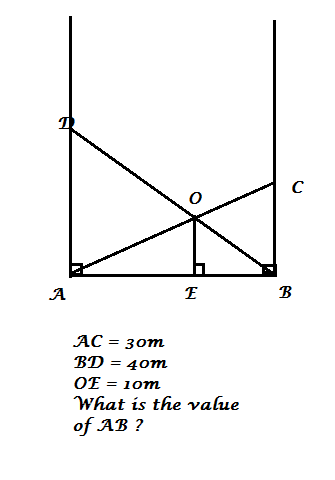Ladders on the walls

Guys please help me with this problem... I've been eating my head off but cannot solve this problem. I used similarity and tried finding the values of AD and BC bt im left with a bi-quadratic equation y^4 - 20y^3 + 700y^2 - 14000y + 70000 = 0 where y = BC Please help. Thank you
No vote yet
4 votes
Easy Math Editor
This discussion board is a place to discuss our Daily Challenges and the math and science related to those challenges. Explanations are more than just a solution — they should explain the steps and thinking strategies that you used to obtain the solution. Comments should further the discussion of math and science.
When posting on Brilliant:
*italics*or_italics_**bold**or__bold__paragraph 1
paragraph 2
[example link](https://brilliant.org)> This is a quote# I indented these lines # 4 spaces, and now they show # up as a code block. print "hello world"\(...\)or\[...\]to ensure proper formatting.2 \times 32^{34}a_{i-1}\frac{2}{3}\sqrt{2}\sum_{i=1}^3\sin \theta\boxed{123}Comments
Here's one approach. Note that:
BCOE=ABAE, ADOE=ABEB⟹BCOE+ADOE=1.
If we denote x=AB, then this gives 302−x210+402−x210=1. You'll probably still get a quartic equation, but at least all terms are even powers of x so you can substitute u=x2 and solve there.
[ Edit: actually this doesn't seem to work since you still get a quartic equation in u after expansion. ]
There is no way to get a nice exact solution for this problem. Values were poorly chosen. Your equation is correct. The correct result is close to AB = 26.
They probably wanted AB = 24, AD = 32, BC = 18, but messed up by the choice of OE.
It is hard to choose 3 integer values for AC, BD and OE so that AB is integer. I can't find anything better than: BD = 119 AC = 105 OE = 30
According to what I have calculated, AB=28.5 m.
First we will use C Lim's approach.
OE/BC + OE/AD =1------------------(1)
OE/AD = OB/BD ---------------(2)
OE/BC = OA/AC ---------------(3)
Adding (2) and (3),
OE/AD + OE/BC = OB/BD + OA/AC
1 = OB/40 + OA/30 [From --------(1) and putting the values of BD and AC]
Solving further, we get an equation,
120=3(OB) +4(OA) --------------(4)
Now, ODA is similar to OBC, which gives us,
OD/OC = OB/OA
(BD-OB)/(AC-OA) = OB/OA
(40-OB)/(30-OA) = OB/OA
Solving further, we get, 4(OA) = 3(OB) --------------(5)
From (4) and (5), we get OA=15 m and OB=20 m.
Now, using pythagoras theorem in triangles OEA and OEB, we get
EA = 5 root5 m and EB = 10 root3 m.
AB = EA +EB = 5 x 2.236 + 10 x 1.732 = 28.5 m
you should have assumed the sides as integers.i know it's a guess but worth trying.if you assume them as integers then you can easily conclude that the answer is 24
Log in to reply
how do u conclude? please elaborate a little. thank u